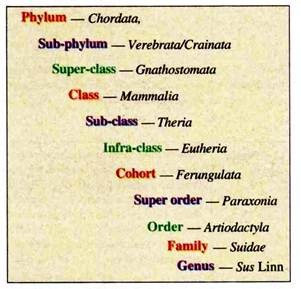In this article we will discuss about Pig Farming:- 1. Introduction to Pig Farming 2. Taxonomic Features of Pig Farming 3. Advantages 4. Target Group.
Introduction to Pig Farming:
Our country is facing the challenges of securing food. So nutritional security to fast growing population needs an integrated approach for livestock farming. Piggery is most potential source of meat production among the various livestock species, and more efficient feed converters after the broiler.
Apart from providing meat, it is also a source of bristles and manure. Pig farming can provide employment opportunities to seasonally employed rural farmers and supplementary income to improve their living standards.
Pigs are regarded as an animal which are roaming on the dirty places and eating faeces and other waste materials. Occasionally chasing human and hurting them badly. General people of India for a long time were avoiding it and kept it away from home and locality. These are not popular as source of protein supplement.
ADVERTISEMENTS:
Even today this is not taken as food by majority of the Indians, because of their dirty appearance and behaviour. However, gradually the scenario is changing. Nowadays these are cultured in a good hygienic farms, and good varieties of pig- breeds are imported. The well-dressed hams are gradually accepted by the general people.
It can be predicted that it will be a means of livelihood for some unemployed youths very soon. Pig farming is very important component in North East India. Out of total pig population in India, 28% are grown in this region. Good quality breeds are available at ICAR Research Complex for North Eastern Hill Region, Barapani-793 103, Meghalaya.
Taxonomic Features of Pig Farming:
The systematic position of the swine is as follows:
The European breeds of domestic swine were derived from the local wild pig, Sus scrofa, whereas the breeds in the Far Eastern parts of the globe were derived from another wild pig, Sus vittatus. The two types inbred readily.
ADVERTISEMENTS:
The modern breeds of pig evolved from different crossings between the two original types and the present day domestic pig, Sus domesticus is the result of thousands of years of evolution through gradual domestication.
Advantages of Pig Farming:
(1) Pigs convert inedible feeds, forages, certain grain by-products obtained from mills, meat byproducts, damaged feeds and garbage into valuable nutritious meat. Most of these feeds are either not edible or not very palatable to human beings.
The pig has got highest feed conversion efficiency, i.e., they produce more live weight gain from a given weight of feed than any other class of meat producing animals except broilers.
ADVERTISEMENTS:
(2) Pig grows fast and is a prolific breeder, farrowing 10 to 12 piglets at a time. It is capable of producing two litters per year under optimal management conditions. A sow can be bred as early as 8-9 months of age and can farrow twice in a year.
(3) With a small investment on building and equipment, proper feeding and sound disease control programme, the farmer can profitably utilise his time and labour in this subsidiary occupation.
(4) The carcass return is quite high, i.e., 65-80 per cent of live body weight. Pigs are well known for their meat yield. In comparison to other livestock species whose dressing yields may not exceed 65%, greater can be obtained from pig.
(5) Pork is most nutritious with high fat and low water content and has got better energy value than that of other meats. It is rich in vitamins like thiamin, Niacin and riboflavin.
(6) The faeces of pigs are used as a manure to maintain soil fertility. Pigs manure is widely used as fertilizer for agriculture farms and fish ponds.
(7) Pigs store fat rapidly for which there is an increasing demand of pig meat/fat from poultry feed, soap, paints and other chemical industries.
(8) Pig farming provides quick returns since the marketable weight of fatteners can be achieved within a period of 6-8 months.
(9) There is good demand from domestic as well as export market for pig products such as pork, bacon, ham, sausages, lard, etc.
Target Group of Pig Farming:
Small and landless farmers are suitable for pig farming, because it requires minimum land space and financial investment. It provides part-time earning for educated youth having agriculture as occupation.
ADVERTISEMENTS:
Uneducated youth can also be involved in pig culture, because it is easy to handle pigs with minimum involvement. Pig farming provides employment of urban unemployed women, because pigs can be maintained by women.
